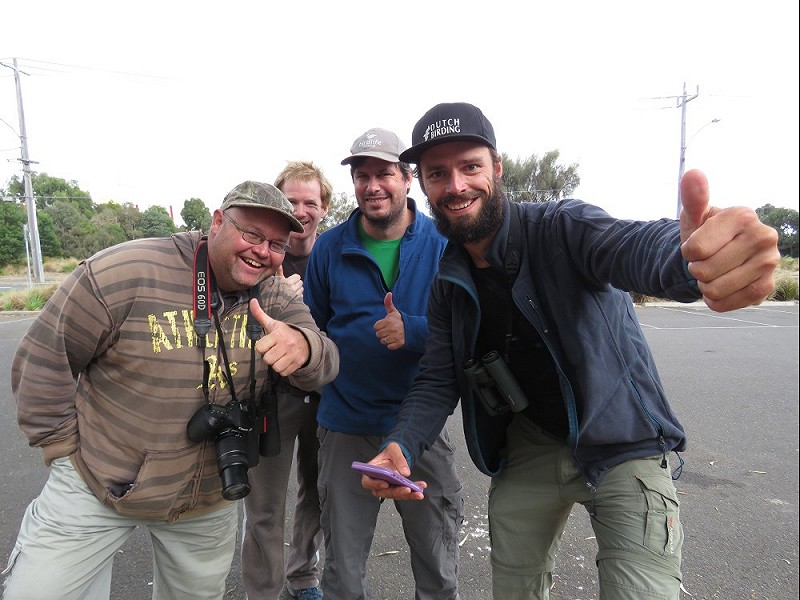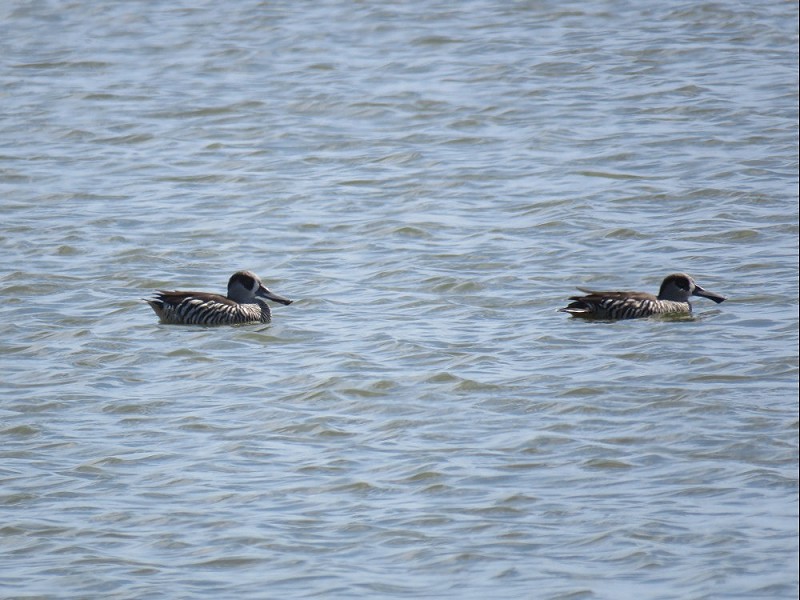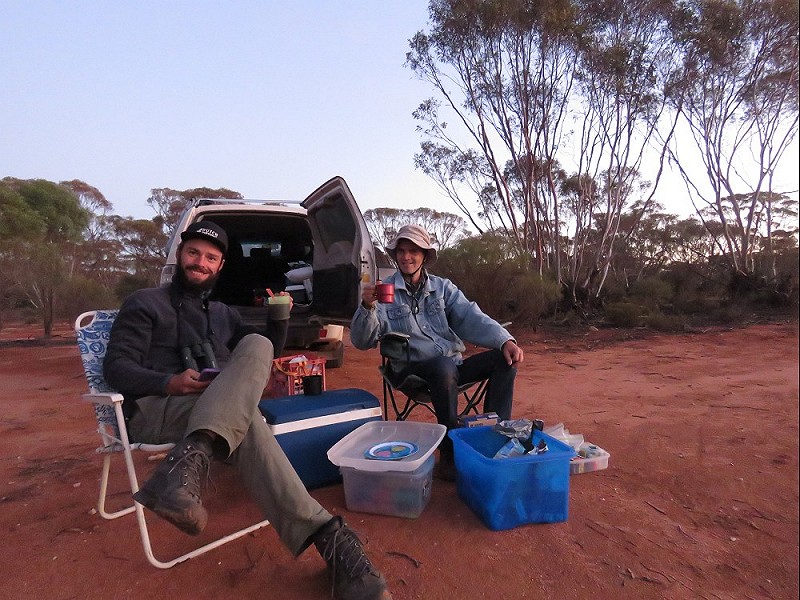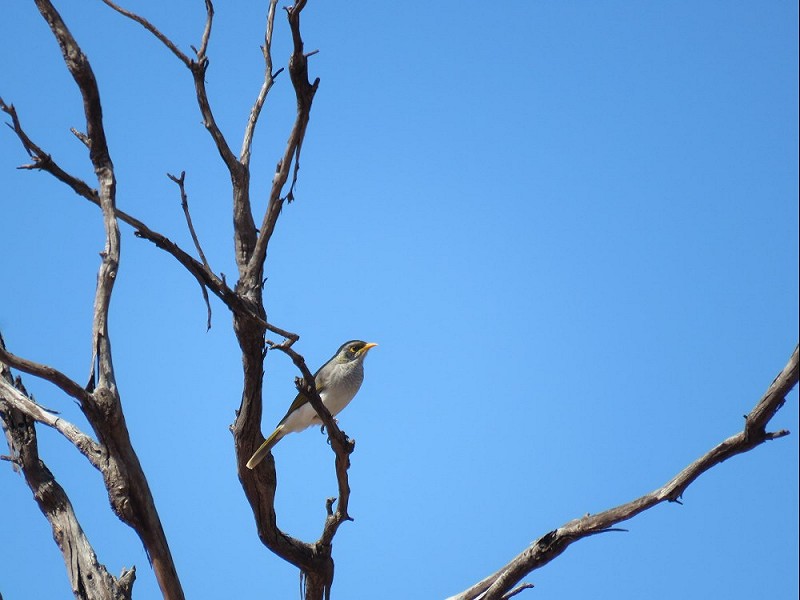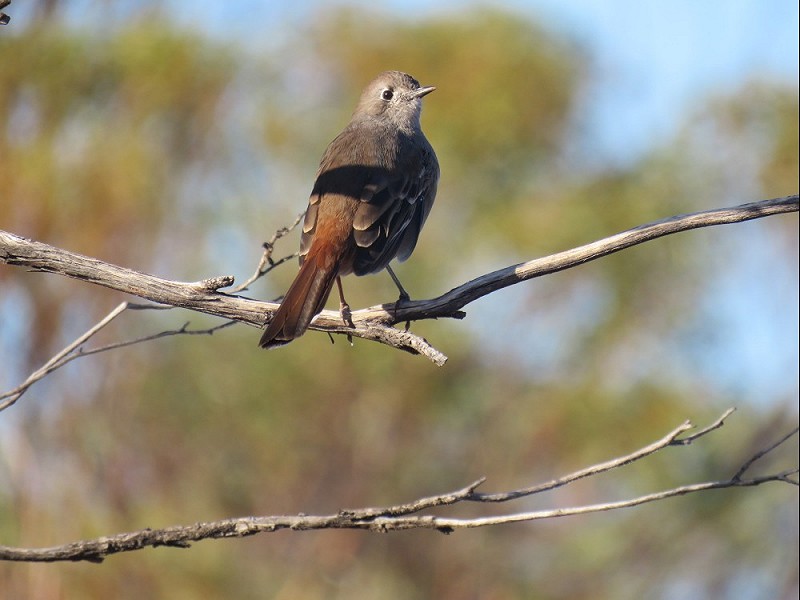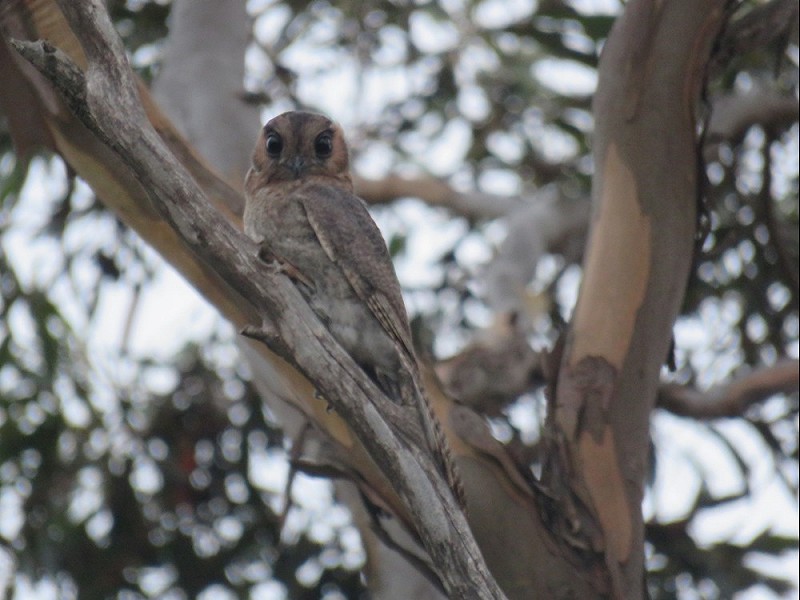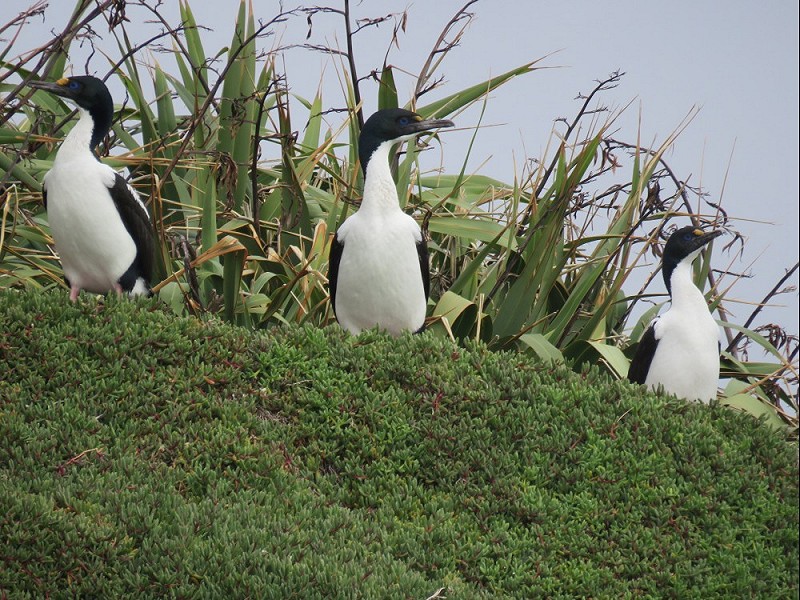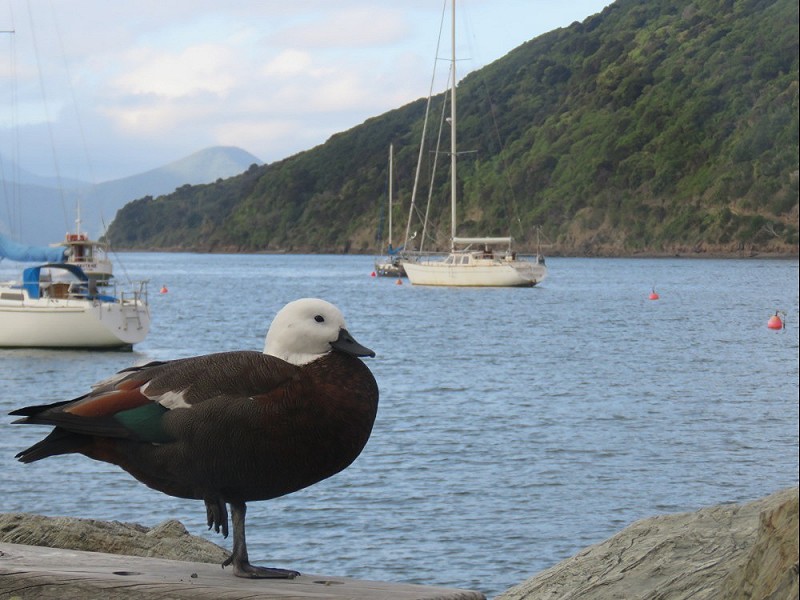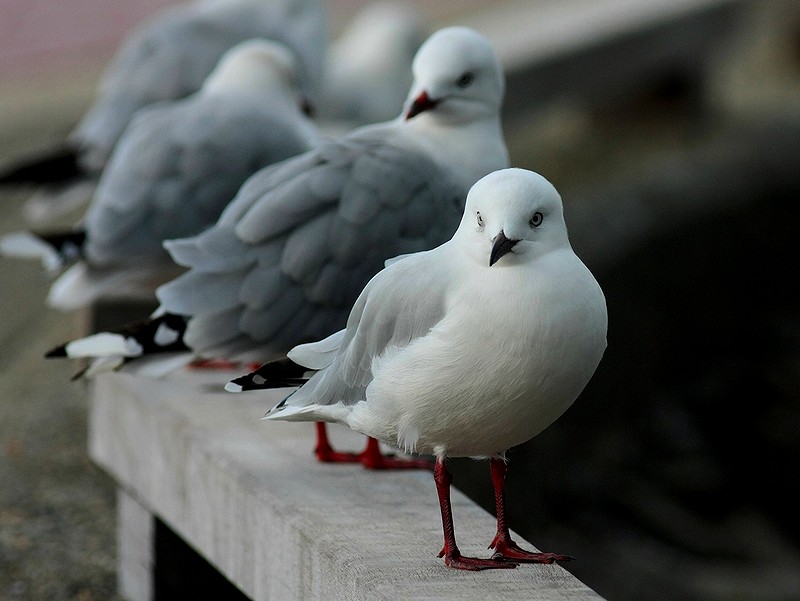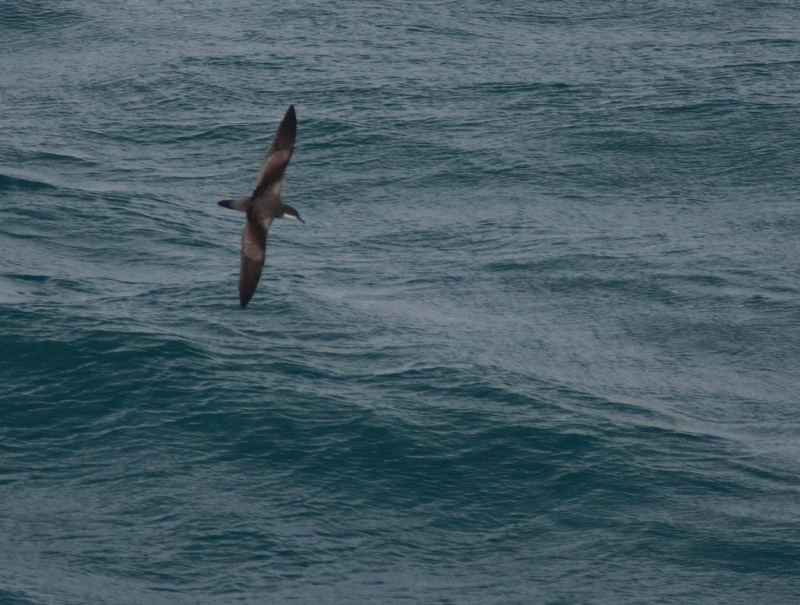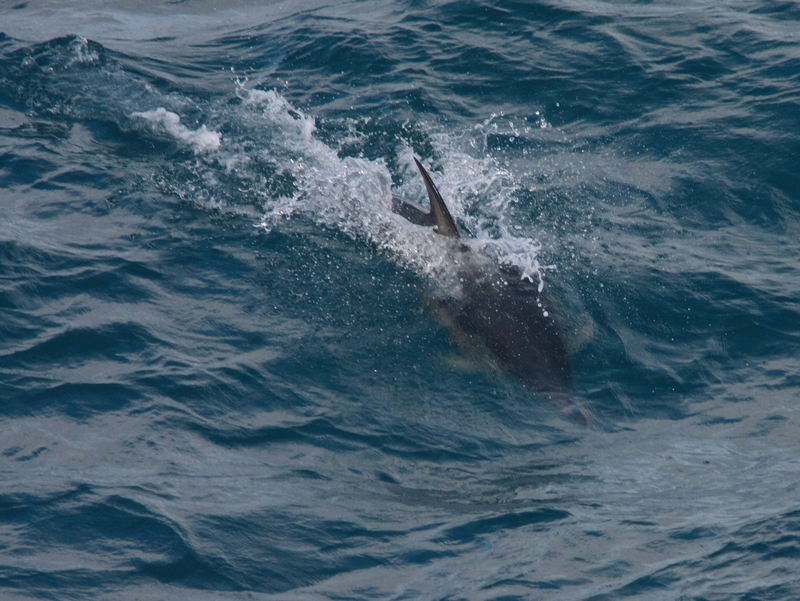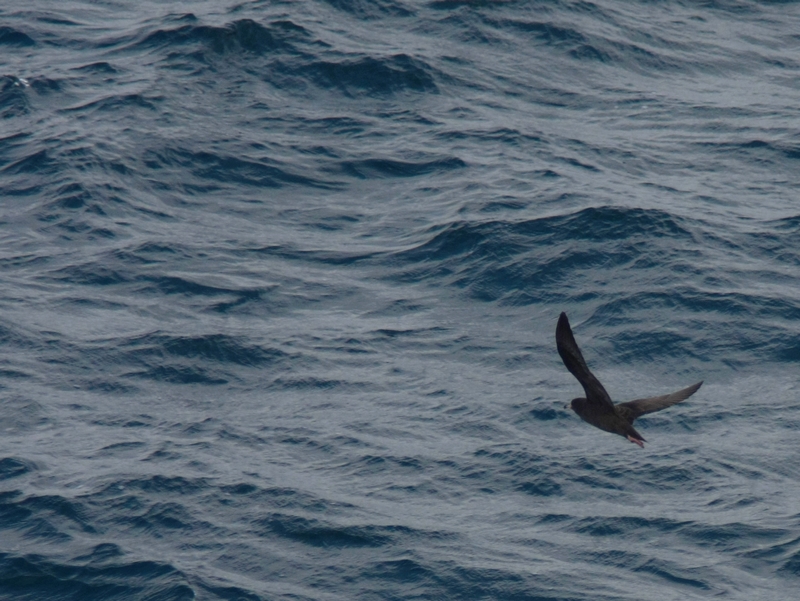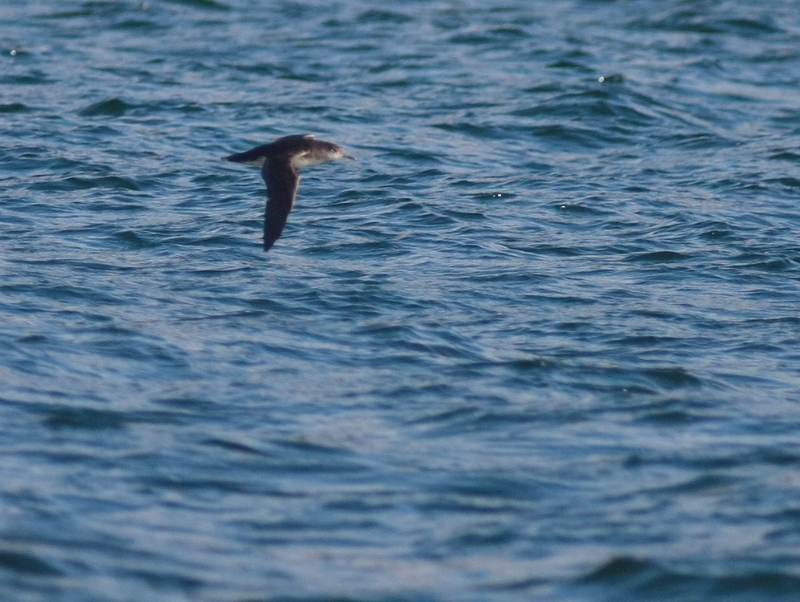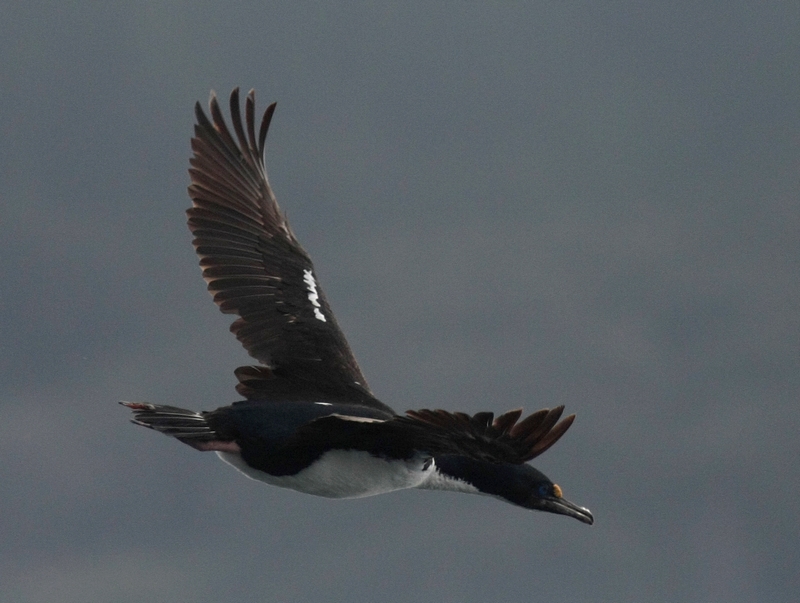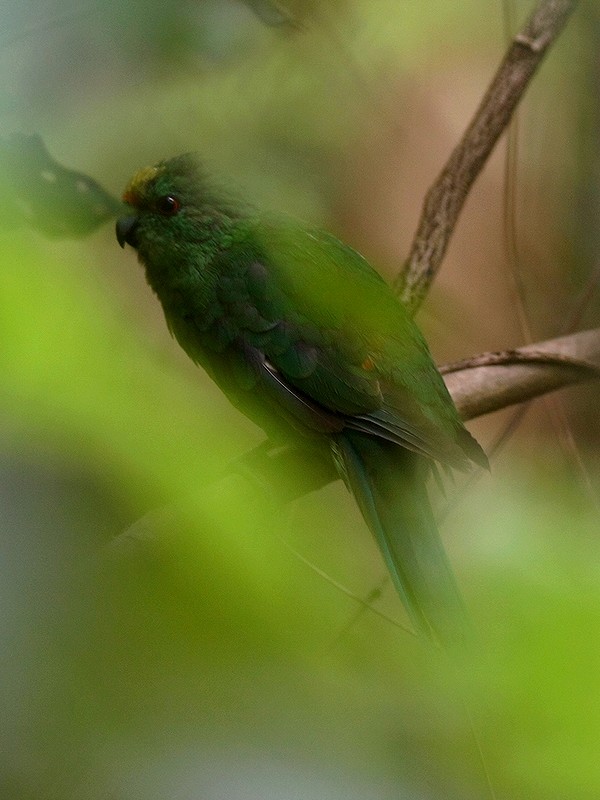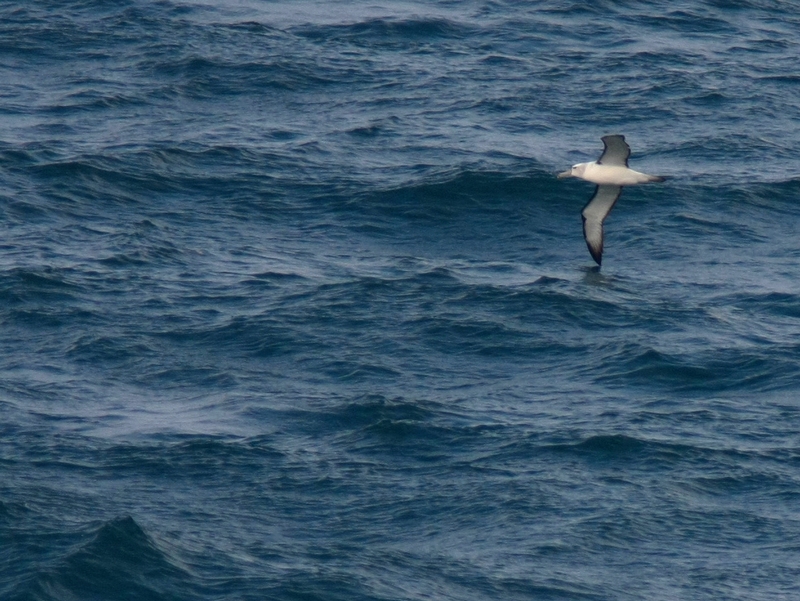March 25 - 31
31 March 2016 · Arjan Dwarshuis · 11538 × bekeken
PLEASE MAKE A DONATION NOW!
http://www.arjandwarshuis.com/#biggestyear
http://world.observation.org/arjan.php
March 25th THE MELBOURNE BIG DAY
After Philip and Tim had picked me up we drove straight to Melbourne where Tim was already waiting for us. Tim is Victoria’s master of owling and mammal watching so I was in for a short night of sleep.
Spotlighting with these guys is no joking around, in a mental pace they scan every tree with their headlights in search of eye shine. In no time we had notched up 3 species of Glider, 2 species of Possum and a Wombat. Biggest Year technically speaking the highlight was a very late in the season White-throated Nightjar and a calling female Powerful Owl that came close, but not close enough for a view.
Philip set up tent almost as fast as he scanned for nightlife and we tucked in for 4 hours of much appreciated sleep. ‘Bassian Thrush calling’! That was my alarm clock at 6:30 AM. I was still falling in and out of limbo so missed the bird. These guys were fast and with a mental 2 weeks PNG and Australia already under the belt I would need to step up my game to keep up! No worries, tiredness is just an emotion ;-)
After connecting with Southern Emu Wren and Rose Robin I had my personal highlight of the day, a displaying male Superb Lyrebird! An absolutely fantastic bird I have been fascinated by since I’d seen the famous Sir David Attenborough video showing this master-of-mimics mimicking a camera shutter and a car alarm while displaying. It is not hard to imagine that these unique and superb looking birds were first thought to be ground-dwelling Birds-of-Paradise.
We left the forest and headed for a park in the suburbs of Melbourne where the endangered Swift Parrot had been seen a couple of days ago. These endangered parrots migrate every year from southern Tasmania to the Australian south coast where they spend the austral winter. I was just too late in the season to connect with this species on Tas so naturally I was keen to find it here.
We had barely set foot in the park when very sharp eared Tim heard the bird calling and moments later we had amazing views of this rare parrot perching on an open branch.
Next we drove to the Melbourne’s most famous birding locality, Werribee. Birding around this site is a real treat and in the couple of hours we had I saw a couple of awesome species: Freckled-, Pink-eared-, Musk- and Blue-billed Duck, Banded Stilt, Red-necked Avocet, Brolga, Black Falcon, Spotless Crake and another catch-up-species that I’d missed in Tas, Fairy Tern, were all seen in a short timeframe.
Our final habitat was the dry zone hills east of Werribee. Thanks to Phil’s spot-on stake-outs we managed to connect with Speckled Warbler, Yellow- and Buff-rumped Thornbill just in time to catch my flight to Adelaide. We ended this huge day with 139 species recorded. Thanks a lot boys for this awesome day’s birding!
March 26th CAMPING OUT AT GLUEPOT
Last night I was picked up from Adelaide airport by fellow Dutchman Peter Waanders, owner of Bellbird Tours. We drove straight to the famous Gluepot reserve, where we set up camp in the middle of the dry mallee.
We had breakfast in front of our tents while the unique birdlife that inhabits this mallee forest woke up all around us. From high-pitched whistles of Southern Scrub-Robins to the deep booming of an Emu. Naturally I couldn’t wait to get out there and look for these fantastic species with Peter, the master of the mallee.
Birding was just awesome in the picture perfect conditions. One of the first birds was an Emu that rushed off as soon as it was on to us, White-browed Woodswallow, Hooded Robin, Crested Bellbird, Gilbert’s Whistler and Mulga Parrot were other nice find, but the absolute highlight was a party of 4 Chestnut Quail-thrush, cracking birds that allowed point blank views as they blended in perfectly in their dry environment.
After the morning run Peter I went after one of the star birds of the mallee, the very rare Red-lored Whistler. Peter is one of the very few people who knows where to find this retiring species. Against all odds – after all it is autumn in Australia and this time of the year these birds are far less active than in spring – Peter located a bird within half an hour. Next we looked for White-winged Fairywren and White-browed Treecreeper, which we both found after a bit of a run-around through the mallee.
Now there was one bird remaining, the critically endangered Black-eared Miner. These birds are under huge pressure due to hybridization with Yellow-throated Miner. How did this came to be? Well us humans sort of reversed an evolutionary process that created a unique species. Before western civilization colonized Australia huge tracks of Mallee Forest dominated the southern part of the continent. To make way for large scale agriculture these mallee forests were logged and burned at an alarming rate. Historically the Yellow-throated Miner favoured the open plains of central Australia and was separated for such a long time from the mallee-favouring Black-eared Miner that the two species evolved. With the burning and logging of the mallee the opportunistic and dominant Yellow-throated Miners colonized southern Australia and started hybridizing with the Black-throated Miners. By now the fate of the Black-eared miner seems sealed, there are less than 100 pure birds left and all of these occur in a tiny pocked of mallee (Gluepot) in family groups with Yellow-throated Miners and hybrids. As you can imagine finding a pure Black-throated Miner is like looking for a needle in a haystack, but luckily I was here with Peter, the expert on this species.
We drove across the sandy tracks of Gluepot in search of Miners, but despite trying and trying we had no success. I had already given up and felt dozed off in the passenger seat as we left Gluepot towards our next destination, then suddenly Peter had a flock of Miners crossing the road. We chased after them and surely there were at least 2 pure Black-eared Miners in the flock! I even managed to take some photographs and film of what is probably the rarest species I’ve recorded so far this year.
On our way to our next camping site we made 3 stops producing a couple of fantastic species, the beautiful White-backed Swallow, the unpredictable Little Eagle and the elusive Australian Crake. What a fantastic taste of birding in the Outback!
March 27th FACE TO FACE WITH A KIWI!
Before my 11:45 AM flight to New Zealand Peter and I went after some last target birds, star off with a smashing Australian Owlet-Nightjar right at the crack of dawn, great to finally see this sometimes tricky bird! Next up was another most wanted species, the Diamond Firetail. These cracking little birds put on a fantastic performance.
After saying goodbye to Peter I boarded my plane to Auckland (NZ), where I had a 40 minute gap to catch my domestic flight - Clearing customs and 800 meters running from Auckland International to Domestic – to Wellington. All luckily went well and upon arrival in Wellington Johannes Fischer – fellow Dutchman turned New Zealand’s’ first and foremost South Georgian Diving-Petrel researcher – was already waiting for me with a coffee. ‘No time to waste, we are going to look for Little Spotted Kiwi’! ‘I beg your pardon?! I have a chance to see a KIWI, tonight’?! Yes indeed, Johannes had arranged a customized night walk at Zealandia, New Zealand’s first mainland rat, stoat and cat-free sanctuary. This fantastic place is basically an island on the land where indigenous birds, reptiles, amphibians, insects and even fish can live their lives like they did before us people ruined everything by introducing all these devastating pests. Zealandia’s vision is to someday have a pest-free New Zealand.
We were guided around by the very knowledgeable Allison, who made hid her life’s work to save New Zealand’s amazing fauna. So happened that the very first bird I saw was immediately the most amazing of them all, the Little Spotted Kiwi! What an amazing experience, we saw 2 unringed birds, which means that they were never ever handled before by human beings. Seeing a Kiwi scurrying through the undergrowth in dim red light – they react badly to direct torchlight – was one of the coolest experiences of my Biggest Year so far. Another amazing sighting were two mating Brown Teals, I thought I’d put the whole thing on video, but unfortunately I forgot to press ‘record’…
March 28th THE MOST CRAZY LIST OF BIRDS IMAGINABLE
Today Johannes and I would try the impossible, thanks to a crafty itinerary by Johannes we would visit both a North Island- and a South Island sanctuary and do a pelagic on the same day! How you ask me? Here follows my account of a ridiculously cool day on Kiwi Island…
Before dawn we were back at Zealandia, where we had just 45 minutes to see all the native land birds that occur here… Amazingly we found another Little Spotted Kiwi and had fantastic views of a Morepork – New Zealand’s only none extinct – native owl before daybreak. And so it began: Kaka, Red-crowned Parakeet, North Island Sadleback, North Island Robin, Stitchbird, New Zealand Fantail, New Zealand Scaup, Grey Gerygone and Tui were all seen within a very short timeframe and to top things off I spotted a New Zealand Falcon sitting on top of a tree! In the dying seconds we even found our last target, a prehistoric looking Takahe that had just waken up… pfewww.
We raced down to the taxi and arrived at the jetty just in time to catch the Cook Strait ferry, the pelagic began! Fluttering Shearwater was the first ‘Tubenose’ we encountered, but as soon as we hit open waters the spectacle began. During the 2 ours on open water we saw Hutton’s-, Buller’s-, Sooty- and Flesh-footed Shearwater, Northern Giant-, Westland- and White-chinned Petrel, Shy- and Buller’s Albatross and my 2000th species this year, the tiny Common Diving Petrel.
After our arrival in scenic Picton harbour we ran to the E-kotours jetty, Johannes had arranged that we would diverge from the regular tour to be dropped off at Blumine island, the last home of the critically endangered Malherbe’s – or Orange-fronted – Parakeet.
The boat trip through the Malborough Sounds was a nice build-up to our adventure that began as soon as we set foot on Blumine Island. We were told that these parakeets were extremely difficult to find, but that chances were greatest along a small creek not far from where we’d landed. I would love to tell you that we searched and searched for hours and that we found it in the dying seconds, but no, we found it within 10 minutes after arrival! I even managed some fantastic footage of this cracking little parakeet! Other highlights on the island were New Zealand Bellbird, Tomtit, South Island Sadleback and the flightless Weka.
After the boat had picked us up again we went to a favourite roosting area of the worlds’ rarest Cormorant, the King – or Rough-faced – Shag. We saw about 25 of this beautiful species that is restricted to just the Marlborough Sounds. Another absolute highlight were two Hector’s Dolphins that curiously inspected our boat and allowed arm’s length views.
Back in Picton we raced back to the ferry just in time for our – unfortunately – night-time boat ride back to Wellington. What a day and what an amazing set of species!
March 29th CHASING WADERS
Again an early start, this time to catch our 06:30 flight to Auckland, where the last part of Johannes’ so far absolutely mental 44-hour itinerary would unfold…
After picking up the rental car we drove straight to a swamp 40 minutes from Auckland were we went in search of two target species, New Zealand Fernbird and Australian Bittern, but this time the birding gods were not on our side and there was no sign of either species.
We continued for Miranda, the famous wader roost south of Auckland, where targeted 3 enigmatic little waders, the totally unique Wrybill - as its name suggests its bill that is curved to the side -, the New Zealand- and the Double-banded Plover. We found a large group of Wrybills, but the site had no plovers and time was ticking since my flight would leave in just 2,5 hours!
We had one last option to see the two plovers and luckily our stakeout for New Zealand Grebe was just around the corner. Rest assure, we were victorious and this time in the dying seconds, an hour later I was boarding my connecting flight to Perth, Australia. The first 3 months of my Biggest Year are almost coming to an end…
March 30th A SWEEP THROUGH SOUTHWEST AUSTRALIA
Last night a local birder from Perth, Ross Jones, picked me up from the airport, 3 hours later at 2 AM we left for Cheynes Beach, 500 km to the southeast of Perth. Enormous respect for Ross who slalomed 300 kilometres across a kangaroo-infested highway to our first birding site, a patch of Mallee forest in the middle of nowhere, where we would search for the enigmatic Malleefowl.
We searched for about an hour – that is all what fitted in our very tight schedule – but couldn’t find any Malleefowl. What we did find were 2 Painted Buttonquails, a Spotted Nightjar and several Purple-gaped Honeyeaters. As we continued we stumbled upon multiple flocks of Elegant- and the gaudy Regent Parrot, best however were two Spotted Harriers that gave fantastic views as they hunted over a stubble field.
Another stopover in the Stirling Ranges produced the localized Western Yellow Robin and a finally a pair of Varied Sitella, a much awaited new family for yours truly.
Around 3 PM we arrived at Cheynes Beach where one of the first birds we heard calling was the endangered – and until not so long ago thought to be extinct – Noisy Scrub-bird. The notoriously skulking birds share some last remaining fragmented patches of coastal heath with two other endangered – and also very skulky – species, the Western Whipbird and the Western Bristlebird. After a quick bite to eat we went in search of ‘The big three’, but not before we admired a family of Southern Emu-wren showing exceptionally well.
All three megas were readily heard, but seeing them proved far more difficult. I flushed a Bristelbird from the side of the track at the same time that Ross saw a Whipbird. Ross missed the Bristlebird, I only glimpsed the Whipbird. Amazingly I managed to actually see a Noisy Scrub-bird as it scurried across the track.
Our personal highlight was a flock of 11 Rock Parrots feeding on the beach, my 5th new parrot species today! We finished the day off with 13 Short-billed Black Cockatoos that came in to roost at the Cheynes Beach campsite.
March 31th THE FIRST THREE MONTHS COME TO AN END
My last day in Australia and in fact my last day in the Australasian region, we better had to make it into a good one :)
We had one last bird to look for around Cheynes Beach, the gorgeous Red-eared Firetail, an uncommon and much wanted species of Australian Finch. This bird gave us a bit of run-around, but thanks to one of Ross’s stakeouts we eventually had fantastic views.
Our next stop was several hours drive away, at a small village named ‘Rocky Gully’, the well-known stakeout for Western Corella, a beautiful Cockatoo with a tiny distribution. Luckily a group of 40 Corella’s was hanging out along the side of the road and put on a fantastic performance for us.
Another 2.5 hours further towards Perth we went in search of Rufous Treecreeper which proved more difficult than expected, but eventually – time was running out – we managed to find one.
With just over 1 hour of daylight left we raced towards the outskirts of Perth to look for Long-billed Black Cockatoo, but before we even got there we had 1 bird among a flock of Short-billed Black-cockatoo’s perching along the roadside.
Now there were 2 targets left, Western Wattlebird and Western Thornbill, but it was already after sundown! Luckily we did find two Wattlebirds, but at the Thornbill stakeout all we could find in the fading light was an Inland Thornbill…
We maximized this day to the fullest and thanks to Ross’s implacable timing I was at the airport 2 hours before my flight, perfect!
Epilogue
And so comes the first 3 months to an end… 2045 species in 91 days’ time. I’m still feeling fantastic, not tired at all and I hundred percent love what I’m doing. All of this thanks to the amazing people helped me every step of the way, whether it from back home behind a computer or next to me with a binoculars in mosquito-infested jungles. I can’t wait to start with part two of my Biggest Year, Africa, but first I have a stopover in the Netherlands and 3 days of hardcore birding in Israel ahead of me. Let’s make those days count!
For all you people reading and hopefully enjoying my daily blog, don’t hesitate to take a look at my fundraiser, that’s the main reason I’m pushing things so hard.
Arjan Dwarshuis
PLEASE MAKE A DONATION NOW!
http://world.observation.org/arjan.php
http://www.arjandwarshuis.com/#biggestyear
Discussie
Wouter van Pelt
·
4 April 2016 10:30
Dude, waar haal je de energie vandaan?! Ongelooflijk goed bezig.
Adrian Mann
·
4 April 2016 12:44, gewijzigd 4 April 2016 12:47
Awesome blog, South Australia has some col birds, Owlet Nightjar being a real beauty.
Really loving the adventure.... Keep them coming.
Justin Jansen
·
4 April 2016 13:03
Het is Werribee, Cheynes Beach en Blumine Island als correctie.
Johannes Fischer
·
9 April 2016 00:30
Als correctie, all NZ fotos behalve de eerste twee zijn gemaakt door mij.
Gebruikers van het forum gaan akkoord met de forumregels.


